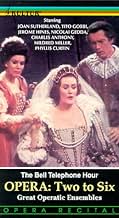Aggiungi una trama nella tua linguaThe long-running television version of the long-running NBC radio series devoted to classical music as well as Broadway composers.The long-running television version of the long-running NBC radio series devoted to classical music as well as Broadway composers.The long-running television version of the long-running NBC radio series devoted to classical music as well as Broadway composers.
- Vincitore di 3 Primetime Emmy
- 6 vittorie e 12 candidature totali
Sfoglia gli episodi
Trama
Lo sapevi?
- QuizWas one of the first TV series to be telecast exclusively in color (using the color TV system perfected by RCA in 1954) and recorded on videotape. Many of the taped performances (several now 50 years old) survive to this day.
- ConnessioniEdited into The Bell Telephone Jubilee (1976)
Recensione in evidenza
Soprano Birgit Nilsson is featured in a solo 45-minute opera recital, taken from a Bell Telephone Hour color telecast.
Beginning with "In Questa Reggia" from Puccini's "Turandot," Nilsson demonstrates she can sing works other than Wagner with great effectiveness.
The air, "Come Unto Me" from Handel's "Messiah" is given a smooth rendition, and Rossini's "Inflammatus et Acensus" presents Mme. Nilsson paired with a strong chorus of mixed voices.
The ensemble performs Faure's lovely "Sanctus" from "Requiem" by itself, and Nilsson concludes the program with three favorite arias, "Pace, Pace Mio Dio" from Verdi's "La Forza del Destino," "Vissi d'Arte" from Puccini's "Tosca" and finally "Brunnhilde's Immolation" from Wagner's "Die Gotterdammerung."
This last rendering, along with an earlier "Elisabeth's Prayer" from "Tannhauser," clearly shows Nilsson's instrument being ideally suited to the Wagnerian repertoire. Not only does she excel in cutting through that composer's often heavy orchestration, but her true personality comes vividly to life in German heroines.
Donald Vorhees beautifully conducts the Bell Telephone Hour Orchestra in this collector's item, produced by Henry Jaffe. Kultur Videos is responsible for having preserved this treasure, and making it available for today's public.
Beginning with "In Questa Reggia" from Puccini's "Turandot," Nilsson demonstrates she can sing works other than Wagner with great effectiveness.
The air, "Come Unto Me" from Handel's "Messiah" is given a smooth rendition, and Rossini's "Inflammatus et Acensus" presents Mme. Nilsson paired with a strong chorus of mixed voices.
The ensemble performs Faure's lovely "Sanctus" from "Requiem" by itself, and Nilsson concludes the program with three favorite arias, "Pace, Pace Mio Dio" from Verdi's "La Forza del Destino," "Vissi d'Arte" from Puccini's "Tosca" and finally "Brunnhilde's Immolation" from Wagner's "Die Gotterdammerung."
This last rendering, along with an earlier "Elisabeth's Prayer" from "Tannhauser," clearly shows Nilsson's instrument being ideally suited to the Wagnerian repertoire. Not only does she excel in cutting through that composer's often heavy orchestration, but her true personality comes vividly to life in German heroines.
Donald Vorhees beautifully conducts the Bell Telephone Hour Orchestra in this collector's item, produced by Henry Jaffe. Kultur Videos is responsible for having preserved this treasure, and making it available for today's public.
I più visti
Accedi per valutare e creare un elenco di titoli salvati per ottenere consigli personalizzati
Dettagli
- Data di uscita
- Paese di origine
- Sito ufficiale
- Lingua
- Celebre anche come
- The Telephone Hour
- Luoghi delle riprese
- Azienda produttrice
- Vedi altri crediti dell’azienda su IMDbPro
Contribuisci a questa pagina
Suggerisci una modifica o aggiungi i contenuti mancanti

Divario superiore
By what name was The Bell Telephone Hour (1959) officially released in Canada in English?
Rispondi























